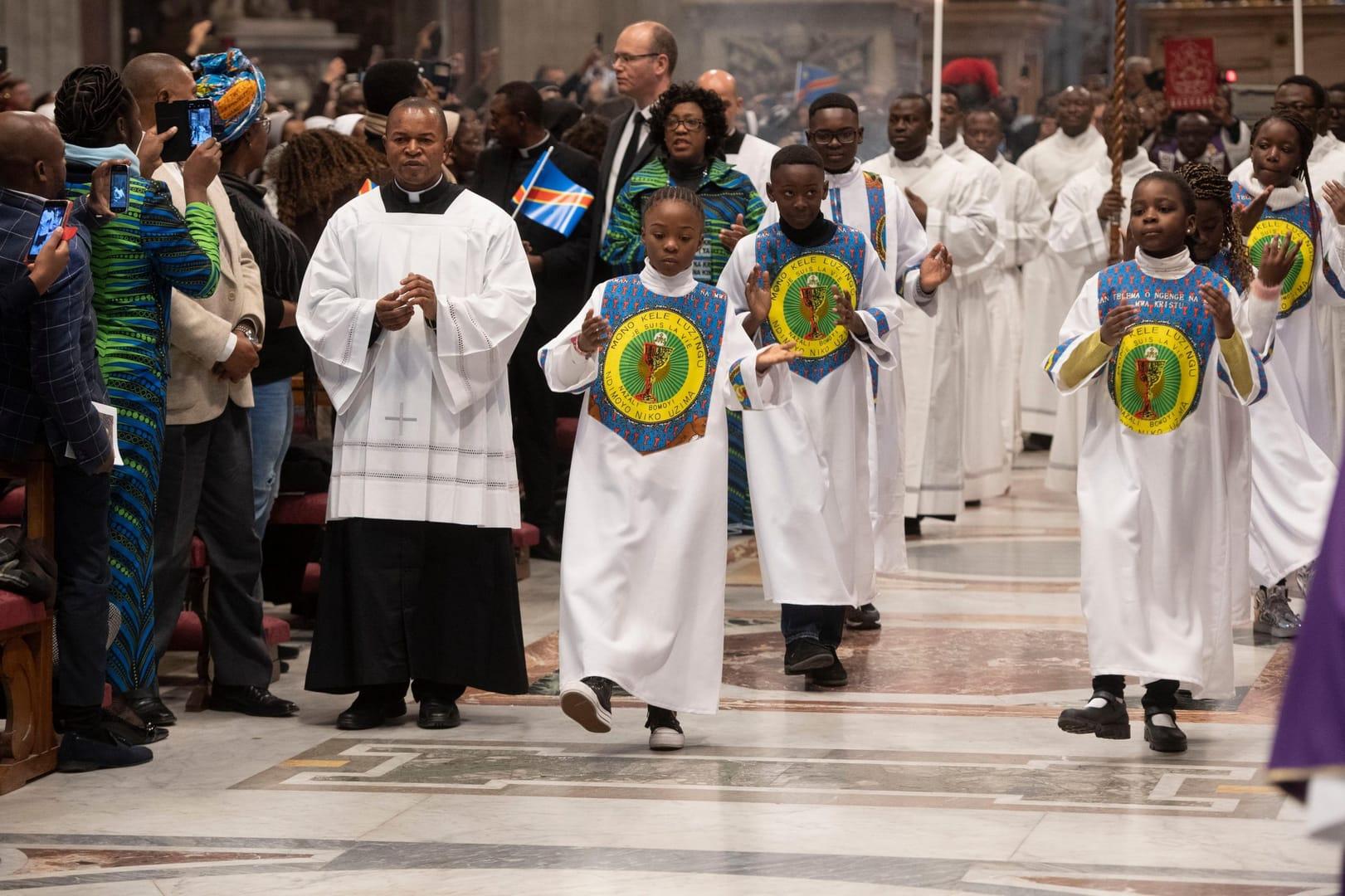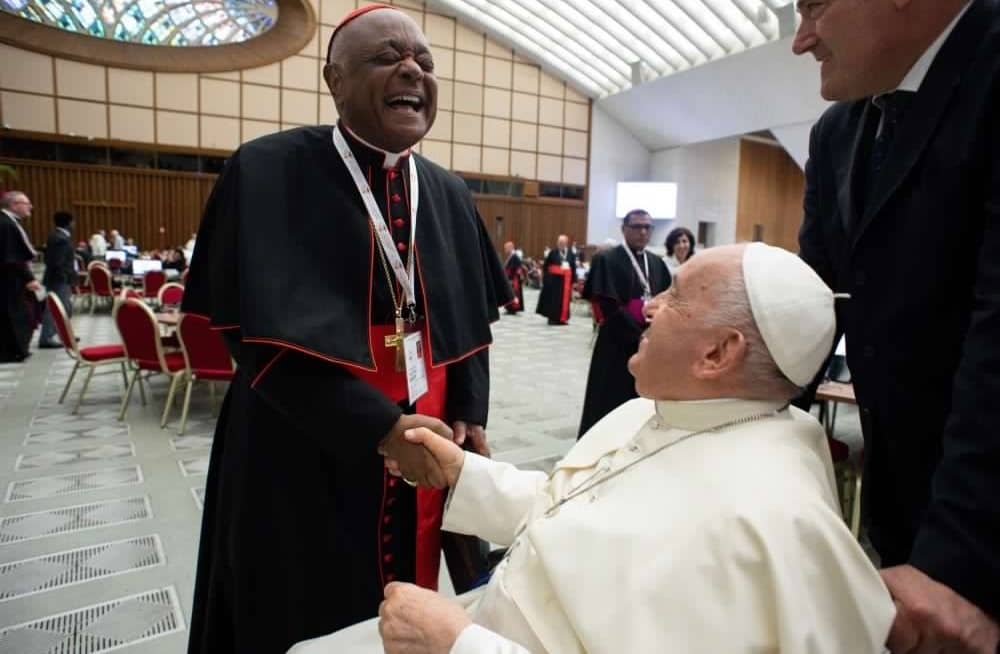YAOUNDÉ, Cameroon – Last year, Pope Francis called the Zairean Rite “the only inculturated rite of the Latin Church approved after the Second Vatican Council.”
The pope’s words came in a book, Pope Francis and the Roman Missal for the Dioceses of Zaire released on Dec. 1, 2020, and edited by Sister Rita Mboshu Kongo, a Congolese religious sister based in Rome.
The Zairean rite was approved in 1988 for the Democratic Republic of Congo, which was then known as Zaire.
“As the only inculturated form of the Eucharist after Vatican II, the Zaire Rite is hugely important. It essentially serves as a prophetic witness to Vatican II’s vision for greater liturgical adaptation, a vision that Roman authorities have largely suppressed,” Nathan Chase, an assistant professor of theology at the Aquinas Institute of Theology in St. Louis, who wrote the article, “A History and Analysis of the Missel Romain pour Les Dioceses du Zaïre.”
“The point of liturgical inculturation is to support the ‘full and active participation’ of the faithful in the liturgy,” he told Crux.
Following are excerpts of that conversation.
Crux: A new book: Pope Francis and the Roman Missal of the Dioceses of Zaire, was published in Rome recently. You have done some studies on this missal. What is the story behind it?
Chase: We often talk about how Vatican II opened up the Church to the modern world. This council was the first to grapple with the global reality of the Church. For really the first time, the Church had to relate to cultures that were not based in the classical cultures of the Mediterranean world. As a result, the Council Fathers knew that business could not continue as normal, so to speak. The Church needed to embrace cultural pluralism and articulate a vision for how God’s presence fills all of creation.
This vision was ensconced in Sacrosanctum Concilium, the Constitution on the Sacred Liturgy. In that document, the council fathers acknowledged the inherent connection between liturgy and culture and allowed for the adaptation of the liturgy to the different cultural contexts in which it is celebrated.
Already, as I point out in my article, before the council there had been a number of attempts at liturgical inculturation in what the Council Fathers rather unfortunately called the “mission countries.” By this they really meant anywhere besides Europe, North America, and Australia/New Zealand.
Modern attempts at liturgical inculturation really date back to the Chinese Rites controversy in the 17th and 18th centuries. In Africa, in particular, there had been a number of attempts at liturgical inculturation before the council, and so the request for liturgical experimentation by the bishops of the Congo after the council was a logical extension of the attempts at inculturation that had been occurring there before the council.
It is also no coincidence that liturgical inculturation happened in the Congo. The Congo was a colony of Belgium, and Belgium was one of the centers for the Liturgical Movement. The vision of that movement, which called for liturgical adaptation, was ensconced in Sacrosanctum Concilium. All of this set the stage for the bishops in the Congo to advocate for a liturgy that they felt would facilitate the “full and active participation” (SC 14). This is after all, the central reason for liturgical inculturation.
How does this rite or the Congolese Mass differ from the usual liturgy as it’s known in the Catholic Church today?
The Zaire Rite is based on the order of the Roman Rite, but also draws off of the role of the tribal chief and the African model of assembly. This has led to some differences in the Rite’s structure. The three main areas of structural difference are 1) the entrance and role of the announcer, 2) the invocation of the saints and ancestors, and 3) the placement of the penitential rite and the sign of peace.
The invocation of the saints and ancestors has been one of the more discussed parts of the Zaire Rite. Since the Chinese Rites controversy, the Church has wrestled with the invocation of the ancestors, in particular the role of those who were not Christian.
The liturgy is also structured around a call and response form, which is much more dialogical than the Roman Rite. As an example, in the Eucharistic Prayers of the Roman Rite, the faithful have very few places where they speak: The dialogue, the Sanctus, the memorial acclamation, and the Great Amen. But in the Zaire Rite, the faithful have acclamations throughout the Eucharistic Prayer.
Then there are the significant differences in the celebration. The Zaire Rite prioritizes processions and dance in particular. The prayers are often locally written too. While a Roman Rite Catholic may be a bit disoriented in the Zaire Rite, they would still be able to follow along I think.
Pope Francis in prefacing the recently published book said that the Zairian Rite is “until now the only inculturated rite of the Latin Church approved after the Second Vatican Council.” How significant is this development? How advantageous to the faith is this concept of inculturation?
This is one of the reasons why the Zaire Rite is so important. It really is the only inculturated form of the Eucharist to be approved by Rome after Vatican II. After the council there were a number of attempts at liturgical experimentation. A number of them were problematic. As a result, Roman authorities became increasingly reticent about liturgical adaptation in the 70’s and 80’s and basically shut down liturgical experimentation, which is the necessary process by which liturgical inculturation comes about. As a result, they essentially shut down the possibility for further liturgical inculturation.
Local churches from Africa, to Asia, to most recently the Amazon, have been petitioning Rome to be more open to liturgical inculturation ever since. Unfortunately, until Pope Francis, their requests had largely fallen on deaf ears. At the same time, Roman authorities allowed for the increased use of the Extraordinary Form of the Roman Rite and allowed for the development of the Anglican Use. This has resulted in a bit of a contradiction.
But as the only inculturated form of the Eucharist after Vatican II, the Zaire Rite is hugely important. It essentially serves as a prophetic witness to Vatican II’s vision for greater liturgical adaptation, a vision that Roman authorities have largely suppressed. The point of liturgical inculturation is to support the “full and active participation” of the faithful in the liturgy. This principle was the motivation for the liturgical reforms outlined in Sacrosanctum Concilium and carried out after the council. This is the central reason for liturgical inculturation – liturgical inculturation is meant to lead the faithful, using their own cultural symbols and practices, into the heart of the liturgy, into the paschal mystery.
So liturgical inculturation is hugely important, because it is not really about how the minister dresses, or other peripheral things, but about how to allow the liturgy to be most salvific for the faithful. It is about salvation.
“The Zairian Rite suggests a promising way also for the possible elaboration of an Amazonian Rite,” said the pope.
Since liturgical inculturation is about supporting the participation of the faithful in the liturgy, and by extension allowing the liturgy to be salvific for them, I think in any cultural context liturgical inculturation is absolutely central.
The goal in seeking to develop an Amazonian Rite is to help the people of the Amazon encounter God through a celebration of the Church’s liturgy which resonates with their own cultural experience.
Some critics point to the fact that earlier in Church history, African culture was not included in the liturgy, and has elements that contradict Christianity.
inculturation, and liturgical inculturation, was a key part of the early Church but one that always provoked disagreements. Paul, for instance, argued about whether the Gentiles could be Christians. Justin Martyr argued that Greek philosophy could be used to describe the Christian faith.
In most every case, those in favor of inculturation, rather than those against it, won the argument. The Gentiles became Christians; Greek philosophy not only was used to describe the Christian faith, but would become central to the formation of the creeds in the fourth century. The early Church always accommodated itself to the cultures in which it was celebrated.
It also is not totally accurate to say that the early church never included African cultures in its worship. Particular liturgies were developed in North African, where there was a strong Berber presence, Egypt, Nubia, and Ethiopia. Many of these were Hellenized African cultures, but still ones that were native to Africa. I would say the early Church actually was very responsive to other cultures. This broke down in the medieval period.
How can culture and religion reinforce each other?
Religion and culture are inherently connected whether people like it are not. Jesus was a Jew, many of the early Christians were Greek. The fingerprints of Jewish and Greek culture are all over the Church. The issue is not whether they are connected, but how they should relate to one another. They must always be mutually informing one another, learning from one another, and at times critiquing one another. This is what is key: that they be in critical dialogue with one another.
















